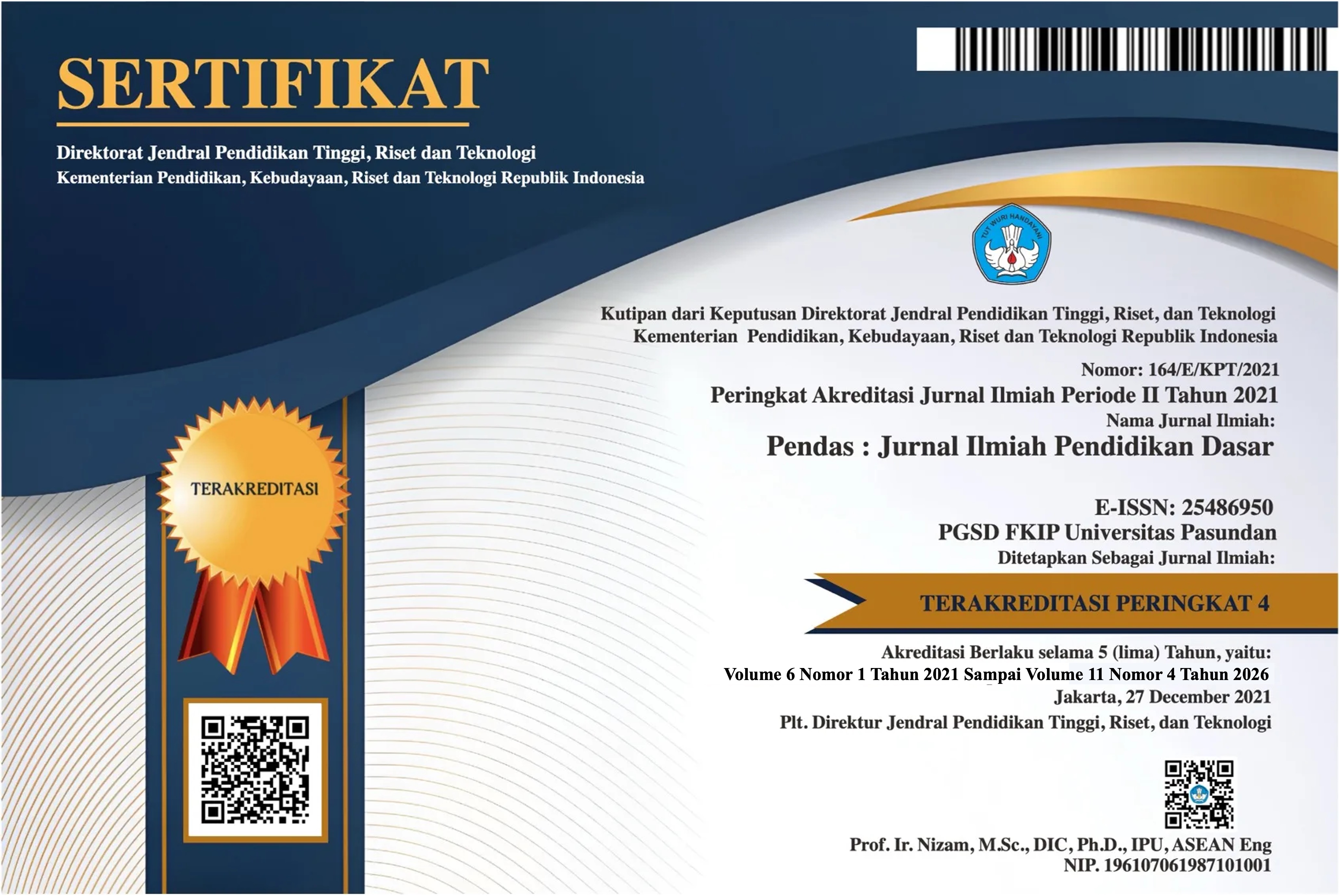DEVELOPMENT OF SCRATCH-ASSISTED TEACHING MATERIALS TO DEVELOP COMPUTATIONAL THINKING SKILLS IN ELEMENTARY SCHOOLS
DOI:
https://doi.org/10.23969/jp.v9i2.13857Keywords:
Computational Thinking, Scratch, Teaching MaterialsAbstract
This research aims to develop a Scratch-assisted module of flat building material to develop computational thinking skills in elementary schools. This research uses the R&D (Research and Development) method with the EDR (Educational Design Research) research model which consists of three stages, namely analysis and exploration; design and construction; evaluation and reflection. Data collection in this study was obtained from the results of validation tests on three material experts (mathematics and informatics materials), one learning media expert, one programming expert, and one pedagogical expert. In addition, data collection was also obtained from the results of student response questionnaires after learning using the Scratch programming module. Data analysis techniques use descriptive qualitative and quantitative. The results of the product feasibility trial from the validator of mathematical materials obtained a percentage score of 77.75% including the feasible category; Informatics material expert validators obtained a score of 86.7% in the very decent category; Learning media expert validators obtained a score of 90% in the very decent category; Expert Programming Validators obtained a score of 96.9% in the very decent category; pedagogical expert validators obtained a score of 76% in the decent category; and the student response questionnaire obtained results of 91.25% with a very decent category. Based on the results of the research conducted, the teaching materials developed, namely the Scratch-assisted module, flat building material are very feasible to be used to help develop computational thinking skills in elementary schools
Downloads
References
Dewantara, I. P. M. (2021). ICT & Pendekatan Heutagogi Dalam Pembelajaran Abad Ke-21.
Hansun, S. (2014). Scratch Pemrograman Visual untuk Semuanya. Jurnal ULTIMA InfoSys, 5(1), 41–48. https://doi.org/10.31937/si.v5i1.218
Iskandar, S. F. R., & Raditya, A. (2017). Pengembangan Bahan Ajar Project-Based Learning Berbantuan Scratch. Seminar Nasional Matematika Dan Aplikasinya, 2013, 167.
Kemendikbud. (2020). Panduan Penyusunan Kurikulum Pendidikan Tinggi.
OECD. (2022). PISA 2022 Assessment and Analytical Framework. In OECD Publishing.
Ormel, B. J. B., Pareja Roblin, N. N., McKenney, S. E., Voogt, J. M., & Pieters, J. M. (2012). Research-practice interactions as reported in recent design studies: Still promising, still hazy. Educational Technology Research and Development, 60(6), 967–986. https://doi.org/10.1007/s11423-012-9261-6
Papert, S. (1980). Mindstorms: Children, Computers, and Powerful Ideas. Basic Book, Inc. http://worrydream.com/refs/Papert - Mindstorms 1st ed.pdf
Rizki, S., & Linuhung, N. (2017). Pengembangan Bahan Ajar Program Linear Berbasis Kontekstual Dan Ict. AKSIOMA Journal of Mathematics Education, 5(2), 137. https://doi.org/10.24127/ajpm.v5i2.674
Rodríguez-Martínez, J. A., González-Calero, J. A., & Sáez-López, J. M. (2020). Computational thinking and mathematics using Scratch: an experiment with sixth-grade students. Interactive Learning Environments, 28(3), 316–327. https://doi.org/10.1080/10494820.2019.1612448
Rubiyah, S., Dasmo, D., & Suhendri, H. (2020). Pengembangan Media Pembelajaran Fisika Berbasis Sparkol Videoscribe dan AVS Video Editor Untuk Siswa Kelas X SMK Mahadhika 2 Jakarta Timur. Schrodinger Jurnal Ilmiah Mahasiswa Pendidikan Fisika, 1(2), 107–118. https://doi.org/10.30998/sch.v1i2.3140
Satria, E., Sa’ud, U. S., Sopandi, W., Tursinawati, Rahayu, A. H., & Anggraeni, P. (2022). Development Of Interactive Animation Media Using Scratch Programming To Introduce Computational Thinking Skills. 10(2), 217–228.
Solihah, B., Suwiryo, S. A., Santoso, G. B., Mardianto, I., & Azzahra, U. A. M. (2022). Pemanfaatan Scratch Sebagai Media Pembelajaran Pemrograman Berbasis Animasi Di Sekolah Dasar. Abdimasku : Jurnal Pengabdian Masyarakat, 5(2), 178. https://doi.org/10.33633/ja.v5i2.469
Sugiyono. (2017). Metode Penelitian Kuantitatif, Kualitatif, dan R&D.
Sunarti, S., Rusilowati, A., Fisika, J., Matematika, F., Ilmu, D., & Alam, P. (2020). Pengembanga bahan ajar digital gerak melingkar bantuan scratch berbasis science,. 9(3), 1–8. http://journal.unnes.ac.id/sju/index.php/upej
Supriatin, C., & Putra, H. D. (2023). Pengembangan Bahan Ajar Materi Garis Singgung Lingkaran Menggunakan Model Problem Based Learning berbantuan Scratch. JPMI (Jurnal Pembelajaran Matematika Inovatif), 6(5), 1851–1864. https://doi.org/10.22460/jpmi.v6i5.20811
Tegeh, I. M., Jampel, I. N., & Pudjawan, K. (2014). Model Penelitian Pengembangan.
Wing, J. M. (2006). Computational thinking. Communications of the ACM, 49(3), 33–35. https://doi.org/10.1145/1118178.1118215
Wing, J. M. (2011). Research notebook: Computational thinking—What and why? The Link Magazine, June 23, 2015. http://www.cs.cmu.edu/link/research-notebook-computational-thinking-what-and-why
Downloads
Published
Issue
Section
License
Copyright (c) 2024 Pendas : Jurnal Ilmiah Pendidikan Dasar

This work is licensed under a Creative Commons Attribution 4.0 International License.



















